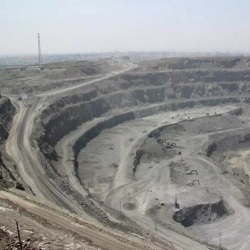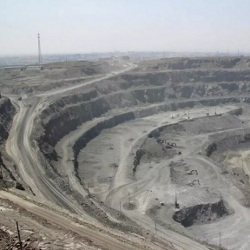
Rare-earth elements are special minerals used in a wide variety of consumer and industrial products. Though they have exotic-sounding names, such as neodymium, scandium, and dysprosium, they are abundant right here on Earth. They are considered rare, however, because they appear in very small concentrations.
In addition, the process used to separate them from the rocks in which they occur is extremely difficult, because the elements have the same ionic charge and are similar in size. Typical separation and purification processes often require thousands of extraction and purification stages to be carried out. As such, there is a significant premium attached to these materials, and several market and geopolitical forces may cause them to escalate in value.
Rare earths are metallic elements, and therefore contain unique properties, including high heat resistance, strong magnetism, high electrical conductivity, and high luster. These specific properties make them well suited for use in a variety of products, including cellphones, batteries, loudspeakers, lights, magnets, and even wind turbines. In addition, they are often key elements used in the creation of components used in everyday objects, such as light-emitting diodes (LEDs), fiber optics, compact fluorescent lights, and are used as catalysts, phosphors, and polishing compounds for air pollution control, illuminated screens on electronic devices, and the polishing of optical-quality glass.
Some of the rare-earth metals (and their atomic weights) that are commonly used in electronics include lanthanum (57), cerium (58), neodymium (60), samarium (62), europium (63), terbium (65), and dysprosium (66).
The demand for rare earths is expected to increase over the next several years, driven by an increase in the use and production of items that are manufactured using rare earths. For example, in 1998, cellular telephones, which have batteries that require rare earth elements, were used by just 5.3% of the global population, according to International Telecommunications Industry data. By 2017, the penetration rate of cellphones worldwide had reached 103.4% (exceeding 100% due to ownership of multiple devices).
In the 1990s, mining companies in China began focusing on rare earths; mines in other countries could not compete with low-cost Chinese mining and processing.
Other products, such as electric vehicles and wind turbines, were just in the prototype phase two decades ago, but have since seen significant commercial deployment, with positive demand forecast over the next several decades. As a result, demand for rare earth elements is likely to grow over time; combined with a relatively limited base of suppliers, rising demand could drive up the cost of rare earths for manufacturers, both in the U.S. and around the globe.
As recently as 30 years ago, rare earths were mined and processed in various countries around the world, including the U.S. However, in the early 1990s, Chinese-based mining companies began developing rare-earths operations, and other mines around the world simply could not compete, due to the lower cost of operations at the Chinese mines and processing facilities. As a result, Chinese-based companies wound up controlling more than 90% of the market by the late 1990s, and prices remained relatively steady.
However, in 2010, China cut its export quotas for rare earth exports, and rare earth prices skyrocketed. Furthermore, a territorial dispute with Japan led China to halt exports to that country for two months, proving its control over rare earths could also be a weapon in any sort of international dispute. Speculators hoarded rare earth minerals, sending prices soaring. Seeing that the Chinese government was actively using its control over the rare earths market to get what it wanted, new rare earth production facilities were started in the U.S., Australia, Russia, Thailand, Malaysia, and other countries.
A potential trade war between China and the U.S., a net importer of rare earths, combined with an expected rise in demand for rare earths over the next few years, could contribute to rising rare earth prices.
When prices of rare earths spiked in the past, manufacturers were able to get their engineers to reduce the requirements for rare earths in some products, such as reducing or eliminating the use of europium and terbium in fluorescent lighting products, says Pierre Neatby, vice president of sales and marketing with Avalon Advanced Materials, Inc., a Canadian mineral development company with three mining projects expected to enter commercialization, including rare earth elements tantalum, niobium and zirconium.
A new red phosphor that uses Manganese4+ (Mn4+) activated fluoride compounds was developed to replace rare earth materials in lighting. However, Neatby says, some products simply require rare earths in order to provide the level of performance demanded by customers.
Indeed, suitable substitutes for neodymium magnets, which are valued because they are extremely powerful and lightweight, have yet to be found, Neatby says. “So, the neodymium magnet is still the most powerful magnet in the world, and for [electric] car applications, you do want the smallest, lightest, motor, because the heavier the car, the bigger the engine has to be in order to move it forward,” Neatby says. “Whether it’s an F-35 [fighter jet], a big submarine, or electric car, rare earth magnets are going to be used.”
Production of military equipment, such as the aforementioned F-35, is at risk of being impacted by the escalating U.S.–China trade war, as are other key pieces of military equipment, such as night-vision goggles, precision-guided weapons, communications gear, GPS systems, batteries, and other defense electronics, each of which requiring rare earth metals as key ingredients.
A provision in the National Defense Authorization Act signed into law in August 2018 bars the U.S. Department of Defense (DoD) from buying permanent rare-earth magnets made in China after December 2018. As there is no domestic source of the materials used to make those magnets large enough to support current demand, the measure will likely force the DoD to purchase rare earths from Japanese producers of rare-earth elements, the main source for rare earths outside China.
The U.S. Geological Survey estimated U.S. manufacturers consumed 11,000 tons of rare earth elements in 2017. Although the Trump administration backed down from imposing steep tariffs on rare-earth elements from China after appeals from U.S industrial consumers of the elements, China has not reciprocated, and U.S. rare earth exports have been hit with a 10% duty now, which could rise to 25% later this year. This tariff is expected to negatively impact the sole U.S. rare earth mine in operation, located at Mountain Pass, CA, and the ability of the U.S. manufacturers to reestablish a self-sufficient rare earths manufacturing industry.
The Mountain Pass mine was acquired last year by U.S.-owned consortium MP Mine Operations LLC, after being shuttered since 2015 by its previous owners, MolyCorp. Inc., when that firm went bankrupt. Mountain Pass operations were restarted in 2018, with the mine’s rare earth compounds now being shipped to China for separation into individual rare-earth oxides, though steep tariffs are likely to negatively impact the company’s ability to compete against Chinese producers.
“The Chinese are still the kings of downstream production of materials that use rare earths; Molycorp has gone bankrupt, and the only outside significant producer of rare earths is Lynas (Corporation of Australia), but they’re producing essentially light rare earths,” Neatby says. “All of the heavy rare earths still come from China, and you have a situation where electric vehicles in the future are going to use electric motors that use rare earths, and demand is starting to pick up.”
Due to the threat of the supply of rare earths being cut off, many companies have stockpiled larger supplies of rare earths. Despite the forces impacting the supply side of the market, demand is likely to remain strong.
“In general, you’ve got a rare earth market that is quite solid,” Neatby says. “All of the applications that were probably not economic have gone away, and so now [the market] is efficient, and focused on neodymium and presidium, and maybe a bit of dysprosium for high-temperature magnets. And traditional applications for lanthanum, cerium, for lanthanum for cracking catalysts for oil and gas, continue to be used. Those are bigger volumes, but [account for] less value.”
The most prudent strategy to ensuring the steady supply of rare earths to manufacturers around the world is to increase mining and refining outside of China. The only current major rare earths producer outside of China is Lynas, which operates the Mount Weld mine in Western Australia, and produces more than 5,000 metric tons of neodymium and praseodymium (NdPr) per year, with most of its output committed to Japanese buyers. Other projects in Australia, Russia, and Brazil are set to enter production over the next several years.
Moreover, there was a large discovery last year of hundreds of years’ worth of rare-earth materials underneath Japanese waters, essentially enough to supply to the world on a “semi-infinite basis,” according to a study published in Nature Publishing Group’s Scientific Reports.
However, the major challenge involves efficiently and cost-effectively separating these rare earths, and a consortium of Japanese government-backed entities, companies, and researchers plans to conduct a feasibility test within the next five years.
Still it is likely that, regardless of the outcome of any trade negotiations to reduce or eliminate tariffs, or the development of a new way to extract rare earths from new deposits, U.S. manufacturers’ best hope for securing rare earths will be the redevelopment of a domestic rare earths industry.
A source close to MP Mine Operations said that the company’s operating plan is to create processing capacity to allow a full, end-to-end mining, extraction, and processing capability in the U.S. within 18 months, which may help to alleviate the pressure on the market. According to a source close to the company, MP Mine Operations is trying to create an American supply chain and is hoping the U.S. government will pressure China to reduce or eliminate import tariffs that affect the company.
James Litinsky, chief executive officer of JHL Capital Group LLC, the majority owner of the Mountain Pass consortium, told Bloomberg News last September that Mountain Pass’ “self-sufficiency will serve as a foundation for an American-based rare earths industry.”
Rare Earth Technology Alliance, What Are Rare Earths?, http://www.rareearthtechalliance.com/What-are-Rare-Earths
Coyne, K.
Moving Past Neodymium: Scientists Explore Alternative to Expensive Rare Earth Element, R&D Magazine, September 27, 2017, http://bit.ly/2OUwHkK
Video: Super Elements BBC Documentary on Rare Earths (2017): https://www.youtube.com/watch?v=GOBKa4vxAOE





Join the Discussion (0)
Become a Member or Sign In to Post a Comment